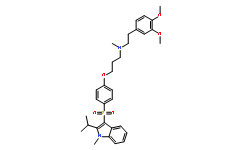| DC72651 |
SG-094
|
SG094 is a potent TPC2 inhibitor with antiproliferative effects. SG-094 can be used for the research of cancer. |
| DC70883 |
VK-II-86
|
VK-II-86 is a carvedilol analogue lacking antagonist activity at β-adrenoceptors, effectively suppresses SOICR by directly reducing the open duration of the cardiac ryanodine receptor (RyR2).VK-II-86 exhibited >2,000-fold lower beta-AR binding affinity than carvedilol.VK-II-86 prevented stress-induced ventricular tachyarrhythmias in RyR2-mutant mice and did so more effectively when combined with either of the selective beta blockers metoprolol or bisoprolol.VK-II-86 prevented hypokalaemia-induced AP prolongation and depolarization but did not alter AP parameters in normokalaemia. |
| DC49692 |
T-Type calcium channel inhibitor(TTA-P2)
|
T-Type calcium channel inhibitor is a potent inhibitor of T-Type calcium channel. T-Type calcium channel inhibitor penetrates well the CNS and blocks the native T-type currents in deep cerebellar nuclear neurons, the window current is completely abolished both for wild-type and mutant Cav3.1 channels. T-Type calcium channel inhibitor has the potential for the research of neurology disease. |
| DC44831 |
MCU-i4
|
MCU-i4 is a negative modulator of the mitochondrial calcium uniporter (MCU) complex that directly binds a specific cleft in MICU1 and decreases mitochondrial Ca2+ influx.,MCU-i4 decreases mitochondrial Ca2+ influx. Docking simulations reveal that MCU-i4 directly binds a specific cleft in MICU1, a key element of the MCU complex that controls channel gating. Accordingly, in MICU1-silenced or deleted cells, the inhibitory effect of MCU-i4 is lost. Moreover, MCU-i4 fails to inhibit mitochondrial Ca2+ uptake in cells expressing a MICU1 mutated in the critical amino acids that forge the predicted binding cleft.[1] |
| DC42326 |
Azumolene
|
Azumolene (EU4093 free base), a Dantrolene analog, is a muscle relaxant. Azumolene is a ryanodine receptor (RyR) modulator and inhibits the calcium-release through ryanodine receptor. Azumolene can be used for malignant hyperthermia research. |
| DC41018 |
SR33805
|
SR33805 is a potent Ca2+ channel antagonist, with EC50s of 4.1 nM and 33 nM in depolarized and polarized conditions, respectively. SR33805 blocks L-type but not T-type Ca2+ channels. SR33805 can be used for the research of acute or chronic failing hearts. |
| DC10947 |
FPL64176
|
FPL64176 is a potent L-type Ca++ channel activator with EC50 of 16 nM. |
| DC10948 |
CDN1163
|
CDN1163 (CDN-1163) is a small molecule, allosteric activator of SERCA2, dose-dependently increases the Vmax of SERCA2 Ca2+-ATPase activity in ER microsomes; increases Ca2+-ATPase activity and significantly enhances Ca2+ uptake into the ER, attenuates H2O2-stimulated cell death in HEK cells; improves glucose homeostasis and metabolic parameters, increases glucose tolerance in ob/ob mice; CDN1163 reduces lipid accumulation and decreases lipogenesis in obese mice livers. |






















